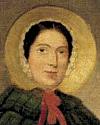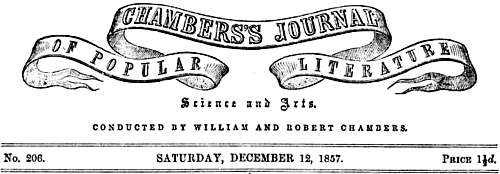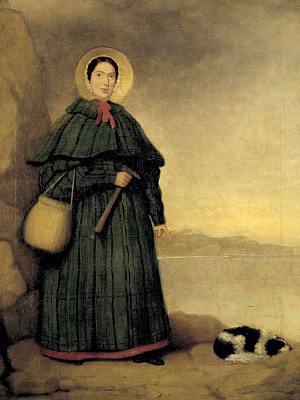 (source)
(source)
|
Mary Anning
(21 May 1799 - 9 Mar 1847)
English fossil collector famous for finding the complete 30-ft fossil skeleton of an Ichthyosaurus before she was a teenager. Throughout her life, she hunted significant fossils to sell to noted paleontologists of her time.
|

The Fossil-Finder of Lyme-Regis.
MARY ANNING
from Chambers's Journal (1858)
[p.382] What trifling incidents may and often do become important in the course of years! We are even tempted sometimes to view them as preternatural, or designed by Providence to be harbingers to future events.
We were led to this reflection when reviewing something we witnessed at Lyme-Regis. We were sojourning there in beautiful weather in the year 1800. A day or two before, a company of strolling equestrians had arrived, and displayed their agility in various performances; but they presented no departure in any point from what we had seen, and for many years after continued to witness in the out-of-door exhibition of vaulting, and the grand finale of Billy Button’s journey to Brentford. In the middle of the performance, tickets were issued for a lottery, in which copper tea-kettles, gown-pieces, legs of mutton, and a silver watch were the prizes. In those days, no charge was made for admission into the field; the riders were remunerated by the profits upon the lottery. Good roads now enable equestrians to carry about a tent with them, and a charge is made for each admission-ticket.
On this evening, attracted by the vaulting, crowds of towns-people were seen making their way to the Rackfield, through the narrow and ancient streets of that borough, by the Cockmoile or prison, Monmouth Street, and the church.
Expecting the arrival of our invalid aunt, we had [p.383] left the crowded ring of delighted spectators standing upon the grass in a level field at the back of the town. The weather was very sultry, and the harvest was nearly in, it being the 19th of August. A passing cloud discharged a heavy shower, and crowds hastened through the streets to their homes. About five o’clock there was an awful peal of thunder, which re-echoed round the fine cliffs of Lyme Bay. Our attention was called, soon after, to a group of noisy talkers, who had an infant, for whom they wanted some hot water. A bath was procured, and the apparently dead child was bathed with ultimate success, amidst the joyful exclamations of the assembled crowd. Three dead bodies were carried home at the same time, one of whom was the nurse of the infant whom she had taken to the Rackfield. There, the three were together with the infant in arms when the shower began, and the whole ran under the dangerous shelter of an elm-tree, when the flash of lightning dealt instant destruction to all but the babe. This baby was the offspring of a carpenter and his wife, who lived near the jail. She had been a dull infant, but was dear to her parents: her name was Mary Anning.
Fifty years before the catastrophe we have described, two very important entries in the world’s bulky catalogue—watering-places and geology—did not exist.
As regards the former, the sea, up to that time, was judged to be designed for commerce, and seaside towns for the residence of merchants and fishermen. There were no migrations to the sea-side. Why should people go to the coast? and at a time when the healthy climate of Northampton was attributed to its distance from the noxious fumes of the sea. There were watering-places, it is true, but these were towns which possessed mineral waters. At this period, however, 1750, Dr Russel, the son of a London bookseller, wrote upon the beneficial effects of sea-water upon glandular affections; and straightway did our countrymen, like so many land-crabs, make towards sea-lodgings wherever they could find them. Dr Russel was obliged to reside at Brighton to direct the bathers, his patients, and old towns were revived in a surprising manner, and new ones founded. Brighton, Hastings, Weymouth, Lyme-Regis, &c., were metamorphosed; Torquay, Worthing, Bognor, Bourne Mouth, Weston-super-Mare, &c., sprang up from the bare shore.
As to geology? This great science was in its earliest infancy, without form or fashion. Some noble pioneers had been clearing the way; but the startling outbreak had not yet taken place. Watering-places had begun when geology was unknown. But what have watering-places and geology to do with our story? You shall hear.
The infant thus recovered, as we have told, grew up a fine lively girl. Her fate was decided by circumstances which rule most of our destinies; and it involves some interesting particulars which pertain to the history of science.
The coaches from London to Exeter passed through Charmouth, two miles from Lyme. A man named Lock, whom Dr Maton, the tourist, calls Curiman— that is, curiosity-man; but who is better known as Captain Cury, had for some time accustomed himself to attend the coaches. He offered for sale curosities to the passengers daily, and adopted the nomenclature of the day for his fossils. There were the bones of crocodiles’ backs and jaws, ladies’ fingers, John Dorie’s petrified mushrooms, &c. This captain was the first vendor of curosities; a Mr Crookshank, a retired London tradesman, was the first collector of such things; and soon a gentleman, named South, came occasionally in the summer in pursuit of interesting objects.
Richard Anning, the infant’s father, was a carpenter, and often accompanied Mr South to the shore. When Richard found anything pretty, he placed it upon a table in front of his residence to attract the attention of visitors. But at length Richard, when on his way to Charmouth in the year 1810, to deliver a message, taking a short-cut, fell over the cliff at the present New Cut, and died in consequence of the injuries he received. This fossil-seller’s visits to the beach had made his wife, Molly Anning, very angry, as she considered the pursuit utterly ridiculous.
After her father’s death, which the family, consisting of a widow, one son, and a daughter, felt sorely in a pecuniary point of view, Mary Anning went down to the shore to look for curosities. She found a cornemonius, a corruption of cornu ammonia, which is now called an ammonite. Her age was then ten years. Something occurred as she was returning which decided at once her future career. A lady in the street, seeing the pretty fossil in her hand, offered her half-a-crown for it, which she accepted; and from that moment fully determined to go down ‘upon beach’ again, and thus find means to support the family. She did so regularly, and roamed over the ledges of blue lias left uncovered by the sea at low-water. When the layer of stone was removed by workmen or the action of the sea, a bed of marl remained. In four months after, Mary Anning saw a bone of some kind projecting from this marl. She traced the organic fossil—a crocodile as was then believed—and men she hired dug it out. H. H. Henley, Esq., the lord of the manor, purchased these organic remains for the sum of L.23, intending the fossil for his private museum; but he eventually gave it to Bullock’s Museum, where it was greatly admired; and the trustees of the British Museum purchased it when the Piccadilly collection and exhibition were dispersed. This so-called crocodile was no less than a specimen of the ichthyosaurus, and what a history does the name of this fossil animal present! It quite engrossed the attention of the scientific world. The great geologists, Buckland, Delabeche, Sir Everard Home, Birch Conybeare, Cuvier, and the elite of that body in this and other nations, were for six years deep in the study of the contribution from the young girl of Lyme-Regis. Mary Anning, now called with great respect Miss Mary Anning, furnished drawings of fragments, supplied deficiencies in published accounts, and proceeded to discover plesiosauri, pterodactyles, and fish more numerous than the present sea produces. Only look round the cases of the British Museum, and you will see that the grandest specimens were found by Miss Mary Anning. The science of geology has become firmly established; honour to those who, and under no small discouragement, laboured in its infancy. Miss Mary Anning was known to Sir R. Murchison, Sir C. Lyell, Professor Owen, Agassiz, and, in a word, to the greatest savans of the age. Many illustrious foreigners made a pilgrimage to Lyme. Her death, when it took place, was a great misfortune to the town; but the inhabitants smiled incredulously when the fact was mentioned. Just so at Yverdun, Pestalozzi having gone to prison for the sum of L.25, no one could see what that could have to do with the welfare of the place. One hundred and fifty residents, however, who had come from Russia and other countries to take lessons from Father Pestalozzi for a twelvemonth, returned home, and the town was nearly ruined.
Mary Anning was of rather masculine appearance. She braved all weathers, and was far too generous in allowing even wealthy visitors to accompany her in her explorations without requiring a fee, as some naturalists now very reasonably do. A cancer in the breast was the cause of the death of this remarkable character, at the age of forty-seven, on the 9th of May 1847. An obituary window has been set up in Lyme Church in remembrance of her. Who can ever hope to fill the place she occupied? Were Mary alive, I [p.384] should like to have extracted from her a list of the famous men of all countries with whom she maintained a correspondence. The Geological Society subscribed towards the window, ‘in commemoration of her usefulness in furthering geology.’ Molly Anning, the mother, who was quite an original, used to say of her famous daughter that she was a history and a mystery. The lower orders, who could not understand what she had achieved, remembered the deadly flash of lightning.
- Science Quotes by Mary Anning.
- 21 May - short biography, births, deaths and events on date of Anning's birth.
- Mary Anning, The Fossil Finder - article from All the Year Round (1865).
- The Fossil Hunter: Dinosaurs, Evolution, and the Woman Whose Discoveries Changed the World, by Shelley Emling. - book suggestion.





